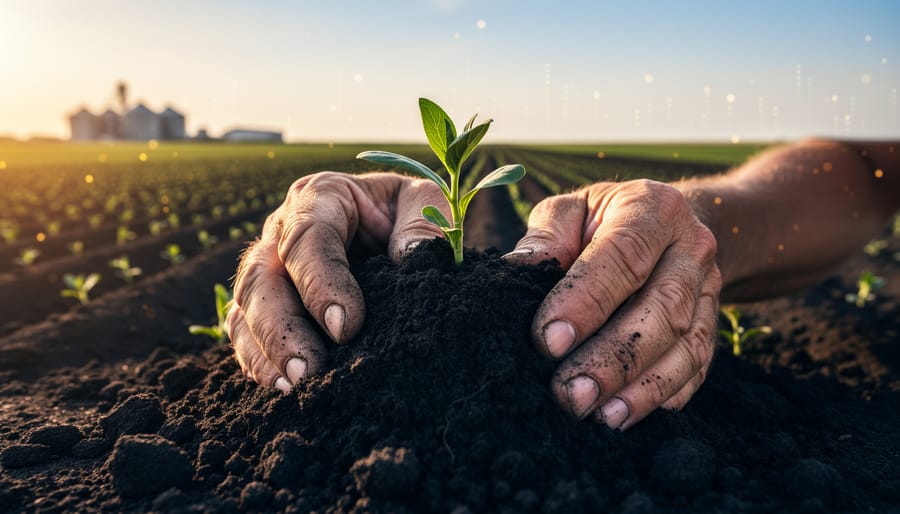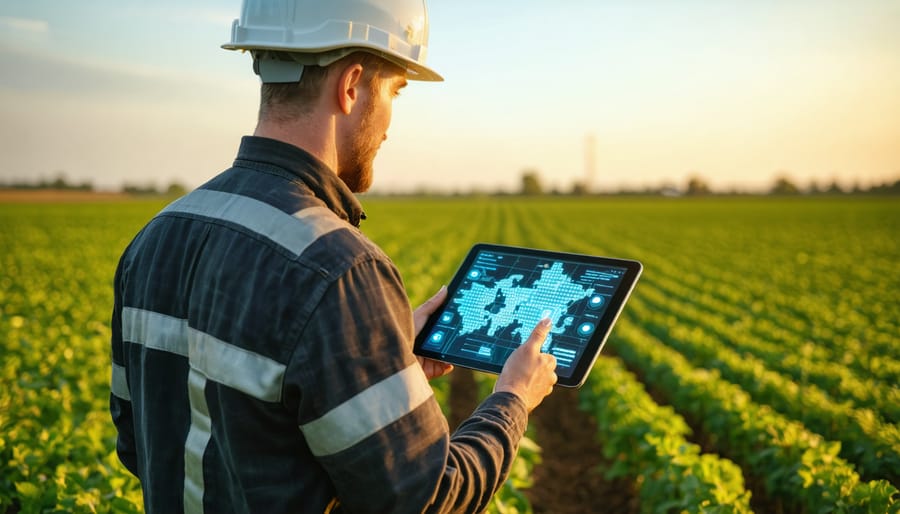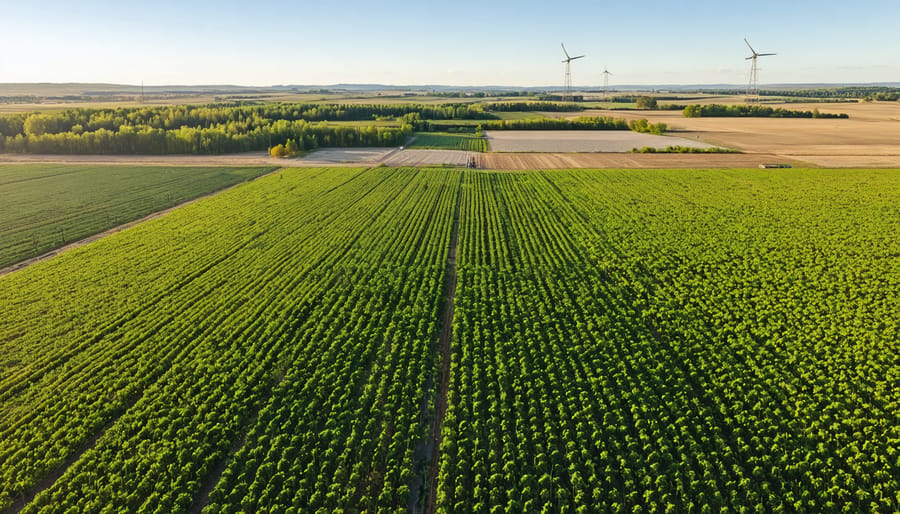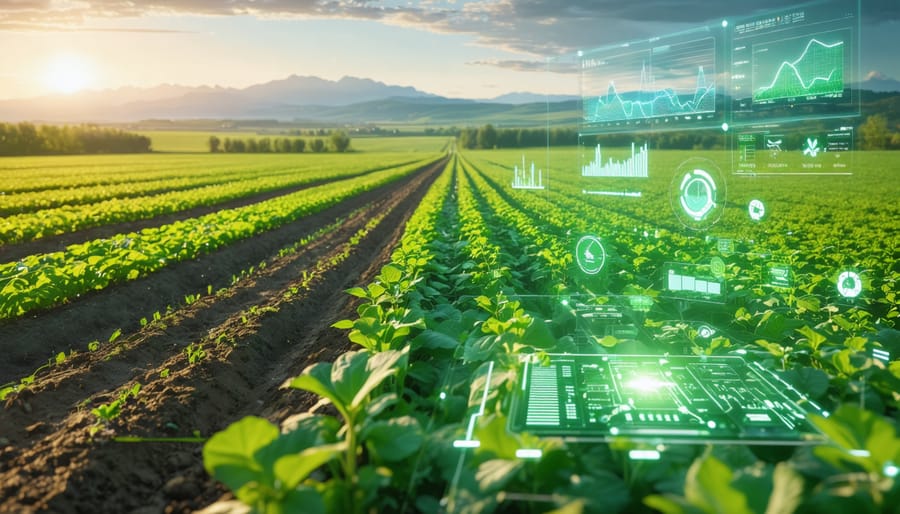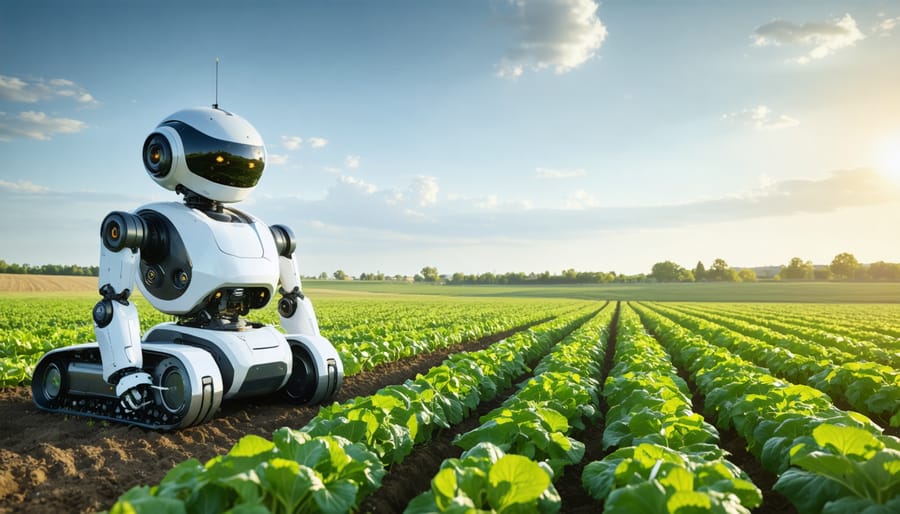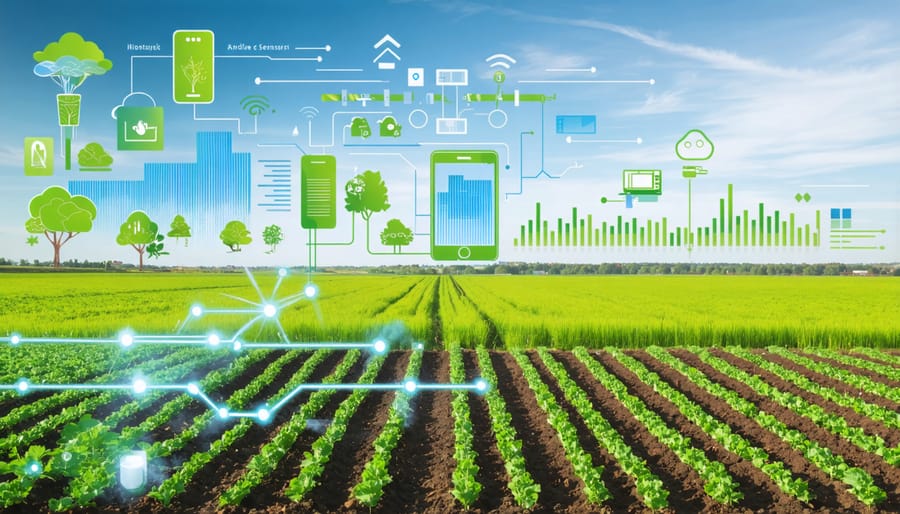Agricultural drones slash field monitoring time by 75% while delivering precision insights that are revolutionizing organic farming in Alberta. Map crop health variations across 160 acres in under 45 minutes using multispectral imaging drones equipped with NIR sensors, enabling targeted intervention before issues spread. Deploy autonomous spraying drones to reduce pesticide usage by up to 30% through spot-treatment capabilities, maintaining organic certification standards while maximizing efficiency. Generate high-resolution 3D field maps showing precise topography and drainage patterns at 2cm accuracy, enabling data-driven decisions for irrigation and soil management.
Canadian farmers implementing drone technology report 15-20% reduction in input costs and improved crop yields within the first growing season. These unmanned aerial systems operate effectively in Alberta’s diverse weather conditions, from early spring soil moisture mapping to late-season harvest planning, providing year-round value for organic operations. Advanced AI-powered analytics transform drone-collected data into actionable insights, helping farmers optimize resource allocation while maintaining strict organic compliance.
The Perfect Match: Drones and Organic Farming
Real-Time Monitoring Without Chemical Intervention
Drones have revolutionized how organic farmers monitor their crops without relying on chemical interventions. By conducting regular aerial surveys, farmers can spot early signs of pest infestations, diseases, and nutrient deficiencies before they become major issues. This proactive approach aligns perfectly with organic certification requirements while supporting natural farming methods.
Here in Alberta, organic farmers are using drones equipped with multispectral cameras to create detailed vegetation index maps, helping them identify stressed plants and potential problem areas. These insights allow for targeted applications of approved organic treatments only where needed, reducing waste and maintaining certification compliance.
“Since implementing drone monitoring, we’ve cut our organic pest control costs by 30% while improving our response time,” shares Sarah Thompson, an organic grain farmer near Red Deer. The real-time data collected by drones helps farmers make informed decisions about crop rotation, companion planting, and natural pest management strategies.
For new organic farmers, drone monitoring provides valuable documentation for certification processes, offering clear evidence of adherence to organic standards through detailed imaging and record-keeping capabilities.
Cost-Effective Field Management
For organic operations in Alberta, drone technology offers remarkable cost savings compared to traditional field management methods. Recent studies from the University of Alberta show that organic farmers using drones for crop monitoring reduce labour costs by up to 30% in the first year alone. These savings come primarily from efficient weed detection and targeted spot-treatment, which traditionally require extensive manual inspection.
Local organic farmer Sarah McKenzie from Lacombe County reports cutting her seasonal scouting hours from 200 to just 60 after implementing drone technology. The initial investment of $5,000-8,000 for a commercial agricultural drone typically pays for itself within two growing seasons through reduced labour costs and improved crop yields.
Additionally, drones help prevent costly organic certification issues by providing detailed documentation of field conditions and management practices, which certification bodies increasingly accept as valid monitoring records.
Essential Drone Applications for Organic Farms
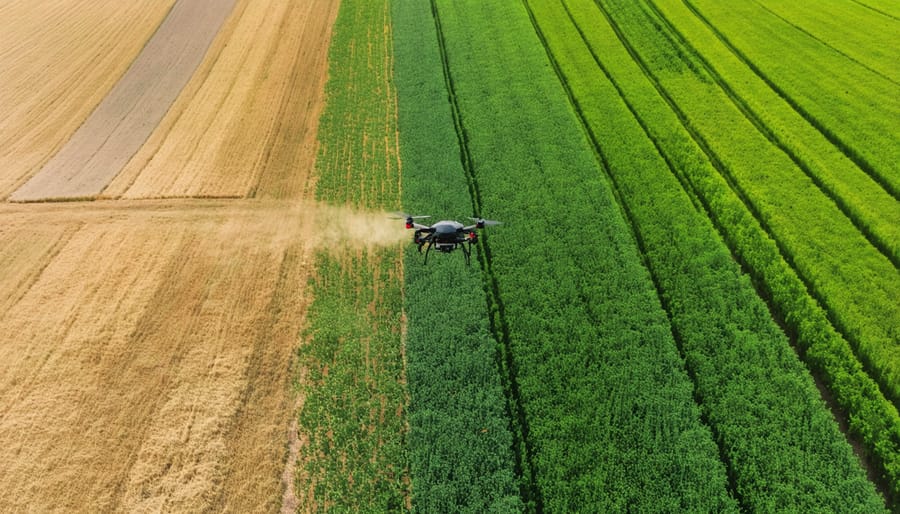
Crop Health Assessment
Drone-mounted multispectral cameras have revolutionized how we monitor crop health across Alberta’s diverse agricultural landscape. These advanced imaging systems capture both visible and invisible light wavelengths, providing detailed insights into plant stress and disease before they become visible to the naked eye.
A key advantage of multispectral imaging is its ability to generate normalized difference vegetation index (NDVI) maps, which show variations in crop vigour across your fields. When flying over canola, wheat, or pulse crops, these sensors can detect subtle changes in chlorophyll content, leaf structure, and overall plant health, giving you a crucial early warning system for potential issues.
Many Alberta farmers have reported catching disease outbreaks up to two weeks earlier using drone surveillance compared to traditional field scouting methods. For instance, a farm near Lethbridge identified an emerging fungal infection in their wheat crop through multispectral imaging, allowing for targeted treatment that saved nearly 40% of their potential crop loss.
The technology is particularly valuable during critical growth stages. By conducting regular drone surveys every 7-10 days, you can track crop development and spot problems like nutrient deficiencies, pest infestations, or irrigation issues before they impact yield. This proactive approach not only helps maintain crop health but also supports more efficient use of inputs and resources, aligning with sustainable farming practices.
Remember to conduct your drone flights during consistent weather conditions, ideally on clear days between 10 AM and 2 PM, to ensure reliable data comparison across multiple surveys.
Soil Analysis and Mapping
Modern agricultural drones equipped with specialized sensors and multispectral cameras are revolutionizing soil testing and monitoring practices across Alberta’s farmlands. These aerial tools provide detailed insights into soil conditions that weren’t possible just a few years ago.
Using near-infrared and thermal imaging, drones can create comprehensive soil health maps that show variations in moisture content, organic matter levels, and nutrient distribution across your fields. This technology is particularly valuable during our prairie growing season, where soil conditions can change rapidly with weather patterns.
Local farmer Sarah Thompson from Lacombe County shares her experience: “We’ve cut our soil sampling time in half while getting more accurate results. The moisture maps helped us optimize our irrigation scheduling and reduced water usage by 30% last season.”
The drones collect data that generates colour-coded field maps, making it easy to identify areas requiring attention. These maps can show everything from drainage patterns to compaction zones, allowing for targeted soil amendments and precision farming practices.
For organic producers, this technology is especially valuable as it helps maintain soil health without synthetic inputs. The detailed soil analysis supports informed decision-making about cover crop placement, rotation planning, and natural fertility management – all crucial elements for successful organic certification.
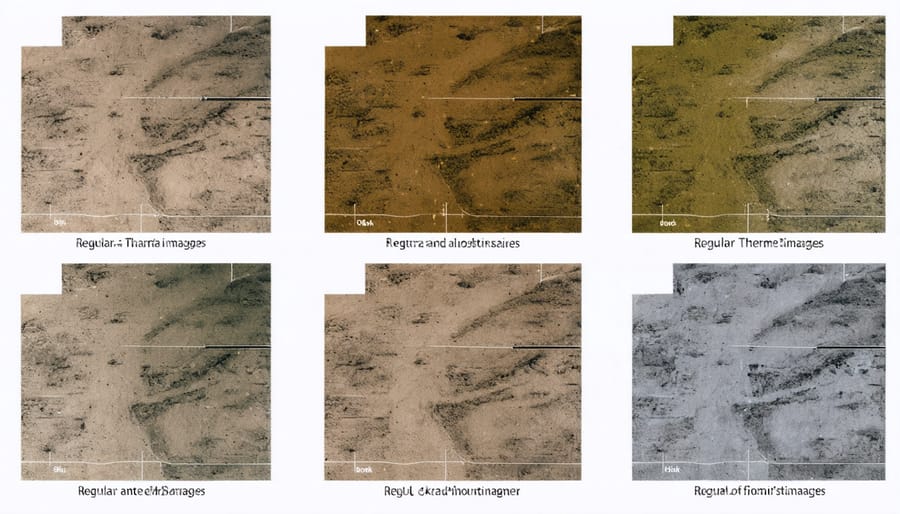
Pest and Disease Management
Drones equipped with advanced imaging technology are revolutionizing how Alberta farmers approach natural pest control strategies, offering a proactive and environmentally conscious solution to crop protection. Using thermal and multispectral cameras, drones can detect pest infestations before they become visible to the naked eye, allowing farmers to address problems early and minimize crop damage.
These aerial scouts can identify subtle changes in plant health, such as temperature variations and chlorophyll levels, which often indicate pest presence. For instance, Prairie farmers using drone surveillance have reported detecting grasshopper populations up to two weeks earlier than traditional scouting methods, enabling targeted intervention with organic pest control methods.
The precision mapping capabilities of drones help create detailed pest pressure maps, allowing farmers to apply biological controls exactly where needed. This targeted approach not only reduces treatment costs but also preserves beneficial insects and maintains the delicate ecological balance essential for organic farming.
Real-time monitoring also helps track the effectiveness of implemented controls. Many Alberta farmers report using drone data to adjust their beneficial insect release programs, ensuring optimal timing and distribution across their fields. This technology-enhanced approach to pest management has helped some local organic operations reduce pest-related crop losses by up to 30% while maintaining their organic certification requirements.
Alberta Success Story: The Thompson Family Farm
Located just outside of Leduc, Alberta, the Thompson Family Farm has become a shining example of how drone technology can revolutionize successful organic farming practices. Sarah and Mike Thompson, third-generation farmers, introduced drone technology to their 400-hectare organic operation in 2019, and haven’t looked back since.
“We were initially skeptical about the investment,” Sarah recalls, “but the returns, both in time and crop management, have been remarkable.” The Thompsons primarily use their agricultural drone for crop monitoring and precision spraying of organic pesticides, which has reduced their input costs by approximately 30% in the first year alone.
Their DJI Agras T30 drone, equipped with multispectral cameras, helps them identify potential issues before they become visible to the naked eye. This early detection capability has been particularly valuable in managing their diverse crop rotation of wheat, canola, and pulses. “Last season, we spotted a developing fungal issue in our wheat field weeks before it would have been noticeable from the ground,” Mike explains. “We were able to apply organic treatments precisely where needed, saving both the crop and our resources.”
The farm’s success with drone implementation has inspired neighboring operations to explore similar technology. The Thompsons regularly host field days where they demonstrate their drone systems and share their experiences with other Alberta farmers. Their careful documentation shows a 25% reduction in water usage and a 20% increase in crop yields since implementing drone technology.
Perhaps most importantly, the Thompsons have maintained their organic certification while modernizing their operation. They’ve worked closely with certification bodies to ensure their drone applications align with organic standards, creating a blueprint for other organic farmers looking to embrace this technology.
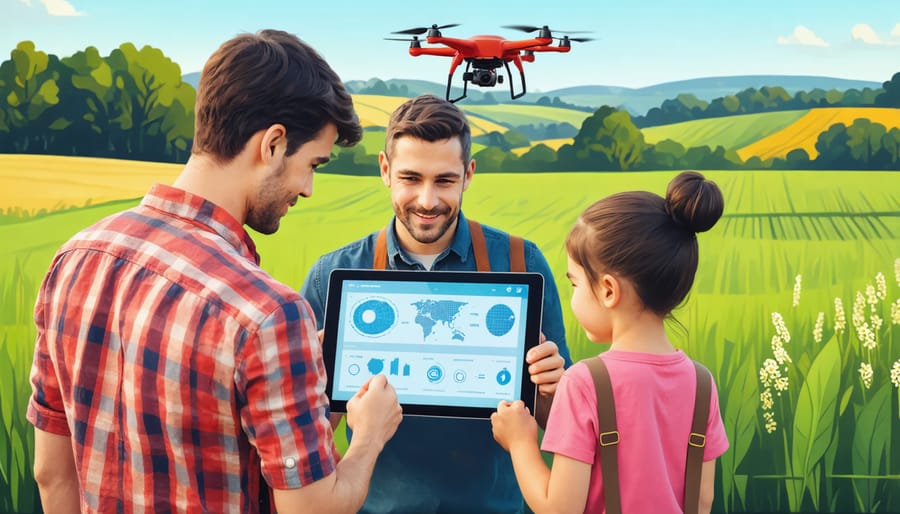
Getting Started with Agricultural Drones
Regulatory Requirements
In Canada, operating a drone for agricultural purposes requires compliance with Transport Canada’s regulations. Farmers must obtain a Pilot Certificate – Advanced Operations if flying in controlled airspace or near people. For basic operations in rural areas, a Basic Operations certificate is typically sufficient. Both certificates require passing an online exam and practical flight review.
Your drone must be registered with Transport Canada if it weighs between 250 grams and 25 kilograms. Each drone needs a unique registration number displayed visibly on the aircraft. Current registration fees are $5 per drone and remain valid for 12 months.
For Alberta farmers, special considerations apply when operating near airports, helipads, or in areas with restricted airspace. The NAV CANADA website provides real-time information about flight restrictions and temporary notices.
Remember to maintain visual line of sight with your drone at all times and carry liability insurance. While not mandatory for basic operations, insurance is strongly recommended and often required by farm insurance providers. Keep detailed flight logs and maintenance records to demonstrate compliance during inspections and maintain good operating practices.
Equipment Selection Guide
When selecting a drone system for your organic farm, it’s essential to consider both your specific needs and the conditions unique to Alberta’s climate. For most organic operations, a multi-rotor drone with a flight time of 20-30 minutes and a payload capacity of 1-2 kg offers the ideal balance of functionality and cost-effectiveness.
Look for drones equipped with high-resolution RGB cameras (minimum 12MP) for basic crop monitoring. If you’re planning detailed plant health analysis, consider models with multispectral sensors that can detect subtle variations in crop vigour. For our prairie conditions, choose drones rated for wind resistance up to 40 km/h and operational temperatures from -10°C to 40°C.
Battery life is crucial in our vast Canadian fields. While entry-level drones might offer 20-minute flight times, investing in a system with swappable batteries or extended flight time can significantly improve efficiency. Consider purchasing additional batteries to cover 100-150 acres per day.
For organic certification documentation, ensure your chosen system includes GPS mapping capabilities and can generate detailed field reports. Popular choices among Alberta organic farmers include the DJI Phantom 4 Pro for beginners and the DJI Matrice series for advanced applications.
Essential accessories for our climate include:
– Extra propellers suited for high winds
– Protective carrying case for dusty conditions
– Tablet or controller with anti-glare screen
– Landing pad for uneven terrain
Remember to factor in training and licensing requirements when budgeting. Many local agricultural equipment dealers now offer drone packages specifically configured for organic farming needs, often including valuable after-sale support and training.
The integration of drone technology in organic farming represents a significant step forward for Canadian agriculture, offering a perfect blend of innovation and sustainability. By adopting these aerial tools, Alberta’s organic farmers have witnessed remarkable improvements in crop monitoring, resource efficiency, and overall farm management. The precision and accuracy provided by drones not only enhance productivity but also maintain the strict standards required for organic certification.
As we’ve seen through local success stories, drone technology is more than just an innovative tool – it’s becoming an essential part of modern organic farming practices. The return on investment, both in terms of time and resources saved, makes drones an increasingly attractive option for farms of all sizes. For Alberta farmers looking to stay competitive while maintaining their commitment to organic principles, drone technology offers a practical solution.
Looking ahead, the continued development of drone capabilities and increasing accessibility of this technology suggests an even brighter future for organic farming. By embracing these tools today, Canadian farmers position themselves at the forefront of sustainable agriculture, ready to meet the growing demand for organic products while maintaining efficient, environmentally conscious operations. The time to explore drone integration is now – your organic farm’s future success may well depend on it.


